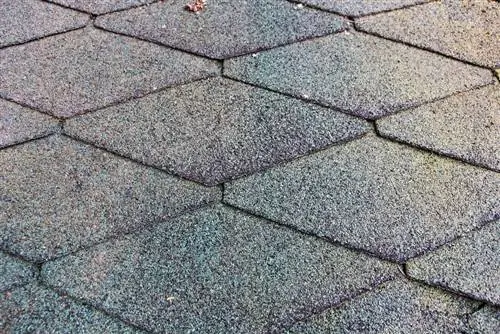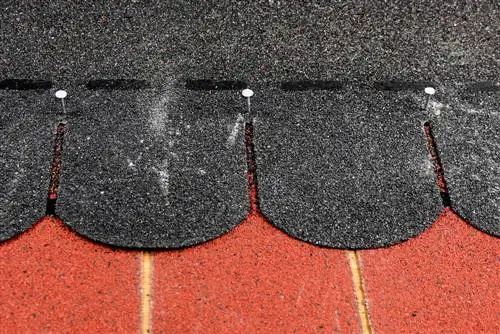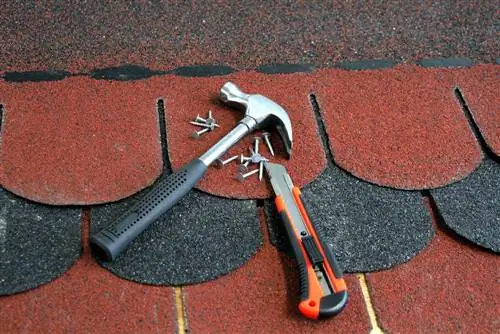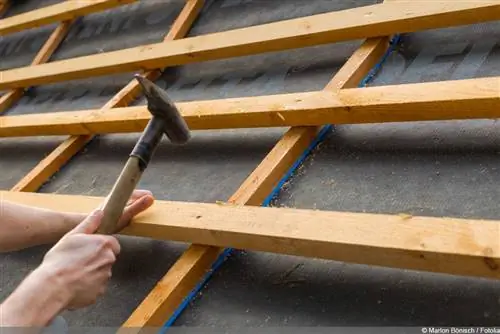- Author admin [email protected].
- Public 2023-12-17 03:39.
- Last modified 2025-01-24 12:45.
Bitumen or plain shingles, as they are also called, are very popular for covering garden sheds, among other things. They are comparatively inexpensive, easy to install and yet have a relatively long service life. However, a number of factors must also be taken into account when laying the shingles. Our step by step instructions show how to do it.
Preparations
Before the plain shingles can be laid, a few preparatory steps must first be taken. These are:
1. Measure the roof and calculate requirements
The length and width of a roof half are measured and multiplied by two. This value corresponds to the roof area. In order to determine the need, an additional 15 percent is added to this value so that there is enough material for the roof ridge and starting strips.
Example:
Length and width of a roof half=4 and 10 m
4 m x 10 m=40 m2 (square meters)
40 m2 x 2=80 m2
80: 100=0, 8=1 percent
0, 8 x 15=12
The 15 percent addition is now added to the roof area of 80 m2. Since these correspond to 12 m2, the calculation for the material requirements is as follows:
80 + 12=92 m2
For the example roof, enough asph alt shingles are required for 92 square meters.
2. Remove gable boards
If the roof has gable boards, these must be removed during preparation.

3. Attach eaves sheets to the eaves edges of the roof
The eaves sheets ensure that rainwater can later run off the roof more easily. However, the eaves strips are only installed after the shingles have been laid. If the eaves sheets are not long enough to cover the entire length of the roof in one piece, two sheets should be used. When laying, make sure that the sheets overlap each other by about four centimeters. In addition, the eaves plate should protrude approximately two centimeters beyond the edge of the roof.
If the eaves sheets have been attached with roofing felt pins, the process is repeated on the other side of the roof.
4. Attach verge plates
Ground sheets are placed on the gable sides and measured and marked using a spirit level. The sheets are cut using tin snips. The fold can also be cut slightly so that the sheets can fit together easily.
The sheets are attached to the roof using so-called clips. This fastening variant means that no further fastening to the gable is necessary.
Once these preparatory steps have been completed, laying the asph alt shingles can begin.
Embarrassed
Some materials and utensils are required for laying the plain shingle. These include:
- Bitumen shingle for the calculated area
- Roofing felt sticks
- Hammer
- Spirit level
- Cutter knife with hook blade
- Pen
Then follow the following steps:
- The roofing felt shingles are laid from bottom to top. So start at the edge of the roof and work in overlapping rows up to the roof ridge.
- For the initial strip, the tongues of the asph alt shingles are cut off. However, enough of it should be preserved so that the notch between the tongues can still be seen. To do this, the shingle is placed on a base so that the tongues protrude. Marks are made on the tracks using a spirit level or other straight tool and a pen. The roofing felt is cut with the cutter knife.
- The first shingle is placed on the eaves plate so that one centimeter protrudes above the edge.
- The shingles are nailed to the upper marked edge with roofing felt pins. Two nails are placed per bitumen shingle. The nails are not completely driven in or sunk in.
- The last shingle is finally cut off at the gable.
- For the second row, half a tongue width is cut off at the beginning of the roofing felt sheet. This creates an offset that creates the characteristic shingle look.
- The second row is aligned so that it covers the adhesive strip by a few centimeters. It is then fixed again with roofing felt pins.
- The third row is laid as indicated by marking and adhesive strips.
- In the fourth row, half a tongue is cut off again to create the offset.
Work like this until the roof ridge is reached. The adhesive strips on the roof shingles are activated by heat. When the sun shines, the bitumen shingles stick together.
Stock up first

The roofing felt must be prepared accordingly for laying the bitumen shingles on the roof ridge.
- The roof shingles are placed on a cut-resistant base and triangles are cut off at the tongues. To achieve an even result, a stencil can be used.
- The roof shingles are laid with the main wind direction, if this is possible. So we start on the side of the ridge from which the wind blows most often.
- The shingles are placed individually on the ridge and secured with two roofing felt pins. They should each overlap by about 15 centimeters.
- The last shingle is glued on with bitumen adhesive and not nailed down.
Tips for laying plain shingles
So that laying can be done quickly and safely, the following tips should be heeded:
Work with at least two people
This is crucial for safety alone, but it can also speed up and make work easier.
Measure twice, cut once
Even if the material is comparatively cheap, waste can be avoided.
Work on warm, sunny and dry days
The faster the bitumen shingles heat up, the faster they stick together and the faster the roof is waterproof.
Protect your hands
The roof shingles and cutter knives can quickly cause injuries, so sturdy work gloves should be worn.
Occupational Safety
Even if the roof of the garden house is not particularly high, you should always pay attention to your own safety.






